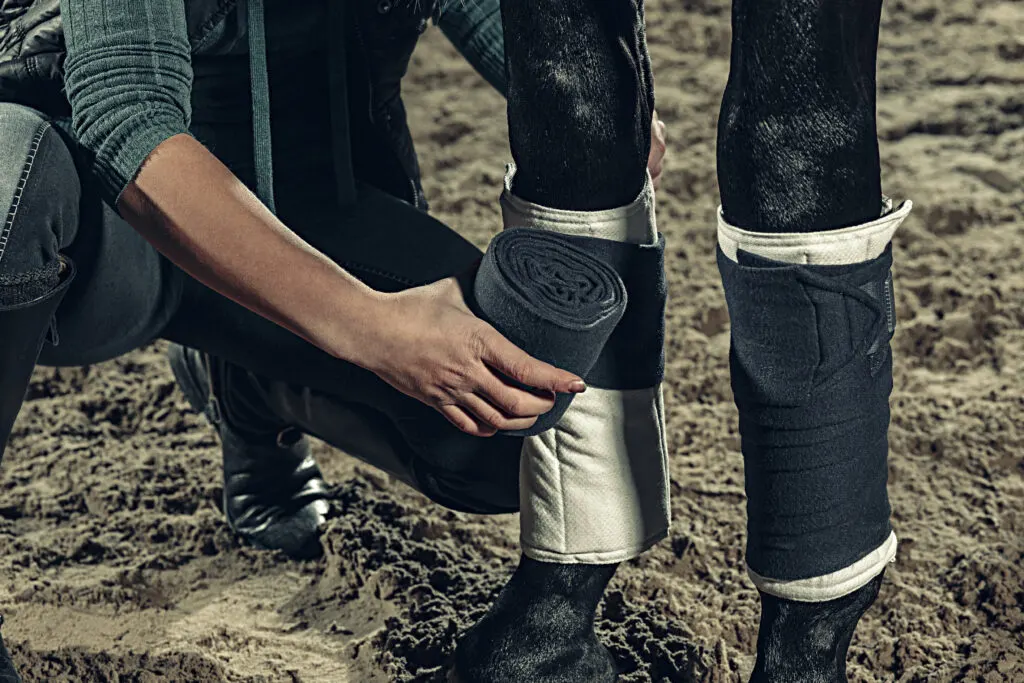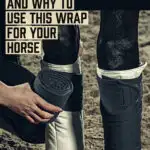
Pillow wraps are never used solo they are always used as part of a two-part bandage:
Part 1. The pillow wrap is the underlying layer that goes against the horse’s skin under standing wraps. Although its name might imply that a pillow wrap is a fluffy and three-dimensional pillow, pillow wraps tend to be more like a small, narrow quilt with minor padding – usually batting (the same padding used in actual quilts) in between two layers of cotton. Sometimes, pillow wraps are made from foam sandwiched between layers of flannel. Traditionally, the pillow wrap portion of a standing bandage is white, although more colors (and even prints!) can be purchased now.
Part 2: Standing bandages or stall bandages are then applied over the pillow wrap. For an illustration of how to apply a standing stall bandage over a pillow wrap see this PDF instruction manual from the Veterinary College of Bristol. Standing bandages are usually a bit less stretchy than more common polo wraps, which makes wrapping with a safe amount of compression a little tricky- for that reason it’s best to let an expert do these wraps.
When these two wraps are combined, the result is a sturdy, durable wrap that, through compression, can prevent some swelling and inflammation after a particularly hard workout or strenuous exercise. Standing bandages with pillow wraps are also sometimes used as a substitute for shipping boots, to help treat tendon injuries, or to cover an open wound during healing.

Important Notes on Using Pillow Wraps:
- Apply in Pairs. Standing bandages should always be applied in pairs. That means: both front legs, both back legs, or pillow wraps and standing wraps applied to all four legs. Putting wraps on one side of your horse but not the other – or even just on one leg – can cause a horse to distribute its weight unevenly which can potentially cause an injury even if the bandages aren’t left on for very long.
- Reapply Wraps 2x a Day. Pillow wraps and standing bandages should be removed and re-wrapped twice a day (every 12 hours).
- Wrap in the same direction. When applying pillow wraps and standing bandages to a horse’s legs, make sure that both the pillow wraps and the standing bandages wrap around the horse’s legs in the same direction. Wraps should always be placed on the horse’s leg by unrolling the coiled wrap from the outside rather than the inside (see linked PDF above for a visual)
- Use the right size pillow wrap for your horse. Pillow wraps should extend from just below the knee or hock all the way down to just below the fetlock. For most horses, this means a standard size standing wrap measuring 14 or 16 inches tall. Very tall horses or small ponies may need custom 10-inch or 12-inch pillow wraps (click to learn more about horse height and determining size).
- Get instructions before applying. Standing bandages must be wrapped with an appropriate amount of compression. Too tight wraps can restrict blood flow, while too loose wraps may come loose and get tangled, potentially causing an injury to your horse. If you’ve never applied standing wraps before, have your trainer or veterinarian demonstrate horse leg wrapping and practice with supervision.

Pillow wraps in the veterinary first-aid kit
Even if you don’t plan on regularly wrapping your horse’s legs in pillow wraps and standing wraps, it’s probably a good idea to have pillow wraps on hand. In our barn, on more than one occasion, having pillow wraps on hand has saved the day, as we found ourselves unexpectedly needing to bandage a wound or deal with inflammation. Because pillow wraps make great emergency first aid for lower leg wounds, there a good idea to have them on hand in your barn’s veterinary first-aid kit.
Do all horses need standing bandages?
No, most horses don’t need standing bandages. Even though a horse’s legs may become slightly inflamed after a very strenuous workout, inflammation (as long as it doesn’t cause lameness or happen too often) is actually a part of the horse’s body’s natural healing process. Unless your horse is in training, competition, or your vet has recommended standing bandages, standing bandages probably aren’t something that you need to make part of your routine horse care practices.

